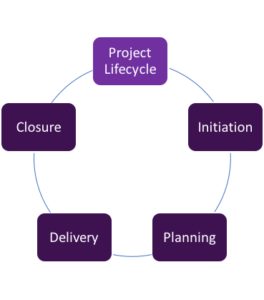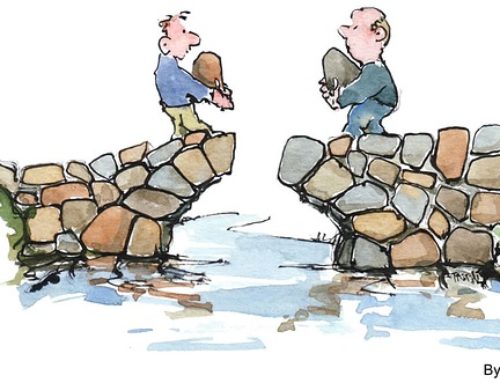Most people will tell you that their project life cycle looks something like the process groups that PMI defines as: Initiating, Planning, Executing, and Closing – while ensuring you are Monitoring and Controlling all variables to ensure quality outcomes.
Sound familiar?
Yes, those are fine phases for a project life cycle, but they are leaving a couple of things out.
 In the article I wrote recently called The Project Doesn’t Start at Charter, I explain why the Initiating phase where most people are doing the charter is not the best place to start if you want to ensure that you and your project team are engaged from the time an idea is created and developed into a business case.
In the article I wrote recently called The Project Doesn’t Start at Charter, I explain why the Initiating phase where most people are doing the charter is not the best place to start if you want to ensure that you and your project team are engaged from the time an idea is created and developed into a business case.
If you want higher success rates on your projects, make sure you are a part of the process to define clear return on investment. You need to be engaged at the development of the business case so that you can truly understand what is expected and how they determined the value this project would provide. You also need to clearly define metrics that will be used throughout the project life cycle to validate that the project is still on track to meet the intended benefits.
When the project deliverables are complete, most people are happily collecting lessons learned and shutting down project activities in a closure phase. We release resources back into the wild and archive all our documents, eagerly anticipating that next project that is staring us in the face. It’s a fresh start. Time to apply all those lessons learned. We are all ready to move on.
But wait…we aren’t done yet.
The project deliverables may have been created and we might have even achieved “project success” by delivering our project on time, on budget and with the agreed upon scope. Great! So, we are done, right?
Well, not quite. You have accomplished the important task of getting the deliverables into the state that they can now begin to show value.
That’s right…begin…we are now at the beginning of the last phase of a full project life cycle, Value Realization. This is the phase when we start to measure the value that the project was originally intended to create and determine whether we were truly successful in project delivery.
For most projects, you don’t immediately achieve 100% of your desired benefits or value the day the project is over and the deliverables are made available for use. For example, if you had revenue goals, expense goals, new client/member engagement, improved productivity, etc., you will require the deliverables to be in use for a period before value will be measurable.
Once you achieve those results, then your project is truly successful. THEN the project is over.
So how do you prepare for this?
I do this by defining a project life cycle that is inclusive of those first and last steps that some organizations are doing anyway, but pulling it into the project management fold a little more clearly to 1) ensure that they get done properly and 2) make sure that a project manager is involved in these steps of the process. Your projects will have higher success rates by doing these two things. Let’s explore why…
- The value of the structured project management life cycle is that we achieve predicable, reliable and higher quality outputs, right? Well, same goes for the crucial steps of building the business case and defining the measurements that we will use to determine if we accomplished the goals set out in the business case. When the project is over, all too often, everyone moves on and forgets to go back and make sure our assumptions and predictions were accurate. Did we win more clients? Did we improve our process? Did we reduce expenses? Did we increase revenue? Are we really more productive? And for all of those questions…if yes, then by how much? If no, then why?
- In many organizations, all the business planning happens without the inclusion of a project manager. Then, the formed (or not so formed) idea is thrown over the fence to a project team to deliver. Leaving the PM out of the business plan development process means they are likely to not have the information that those developing the idea had that led to the decisions and direction the final business case included. There are often unspoken assumptions and decisions that were made that the PM will not be privy to and therefore not have all the information necessary to ensure that the true spirit and intent of the project is realized.
This is what my ideal project life cycle looks like. It’s the one I use in all of my training, the one I implement for all of my clients and the one I used when I was inside organizations responsible for building PMOs and project management methodology. This approach has significantly increased the successful outcomes of projects across the board, in every one of those cases.

Here’s what you want to be doing in each phase to ensure that you are keeping your eyes on the goal of delivering the desired outcomes and value intended.
- Discovery – clearly define the “why” of the project and what benefits are to be expected. Begin to define the success criteria.
- Initiation – define the project scope and determine what measures will be needed to validate that the project delivery achieved the desired outcomes.
- Planning – get very granular with metrics and timing of measurement that will take place during the value phase.
- Delivery – monitor and measure that expected outcomes are still in line with the expected value.
- Closure – ensure that sufficient resources are available to monitor value realization and that plans for measurements and intervals of measurement, as well as reporting requirements, are in place.
- Value – at planned intervals, apply those predefined measurements to the deliverables of the project and ensure that proper reporting and follow up is taking place, driven by the outcomes. Be prepared to perform analysis on “why” if the results are falling outside of the expected range and implement action plans, as necessary. Incorporate findings and lessons learned into future plans. Remember, project success is not defined solely by our ability to achieve the expected triple constraint (time, scope, cost) values. Project success, in the eyes of business leaders, is defined by how well we accomplished the intended outcomes, achieved the expected value and drove the promised IMPACT.
Thanks for taking the time to read this article.
Click here to receive these blog posts right to your inbox.
Fill out our one-minute survey if you have topics you would like read more about.
I welcome your feedback and insights. Please leave a comment below.
See you online!
Warmly,








This is an interesting point. This introduces a different metric for measuring success, not just number of projects completed, but value delivered. I would venture to say that a project that misses time, budget, scope constraints can still be successful if despite missing these constraints it still delivers value. Because sometimes we have to deliver a technical solution to a problem regardless of the constraints.
Yes! Exactly right. 🙂
[…] The Project Doesn’t End with Closure […]